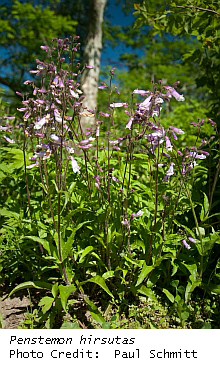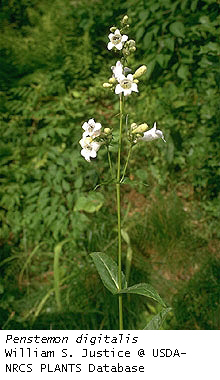Finger Lakes’ Native Penstemons: P. hirsutus, P. digitalis, P. pallidus
I can’t have too many penstemons. I love the colorful western natives, the lush hybrid cultivars, the local natives - pretty much any penstemon will hit high on my attraction index. As I write, I have ten species or cultivars in my gardens, with another few still in the "it MAY germinate" stage. But the happiest penstemons, both in longevity and increasing numbers of plants, are clearly the natives. Not a surprise, really. They bloom mid-June into July in the Finger Lakes.
My favorite native is Penstemon hirsutus, the hairy beardtongue. Hairy beardtongue has a bicolor violet-to-lavender and white flower. Occasionally all white flowered plants occur, and sometimes the violet drifts towards pink. The lower stem and petioles are very clearly quite bristly, and often have a red tinge. The flowers also have glandular hairs. The "plain" species gets 10-24 inches tall, with most of the foliage in a basal rosette. There is a pygmy form that is fairly common within the rock gardening community, where the entire plant flattens to under 5 inches with the flowers and leaves the same size as the larger form. I have both, and seeds from the pygmy form will give a mix of sizes. For troughs, I like the pygmy form, but for most locations the "normal" form is both more visible and more in scale. This species is extremely easy to grow from seed. It is happy in regular garden soil, nasty dry clay, well drained sandy mixes, and thin soils over rocks. In nature it is found in thin alvar soils, in cracks in rock cliffs, and in drier areas where the conditions limit competition. Seeing it in the wild is a thrill - it can appear as a single delicate treasure or a stunning swath of colored wands. As with most Penstemon, P. hirsutus needs a fair amount of sun, but it can tolerate a bit of shade. In rich soils it can be susceptible to fungus diseases in humid summers. It cannot compete with lush plantings but volunteers will sometimes show up in the midst of shorter plants. A dry rocky slope covered with Penstemon hirsutus in varying shades of pinks & purples is quite a sight in late June. I find that this species will send out sporadic blooms throughout the summer.Penstemon digitalis, the tallus slope beardtongue, is seen mostly in ditches and moist meadows around here, but it can take normal garden conditions. The species is 2-4 feet tall, with white flowers showing tiny purple veins. A popular commercial cultivar is "Husker Red", where the foliage has a dark hue with red leaf veins. The plain species can show some red veins and petioles amidst the green, and some bristles on the stem. The blossoms are hairy, but the overall scale of the leaves easily differentiates this Penstemon from P. hirsutus even before flowering. The seed pods and seeds are similarly larger than those of P. hirsutus. Penstemon digitalis also self sows easily, becoming a large clump which glows when in bloom.
Until a couple of years ago, I thought these two were the only native Penstemon in the Finger Lakes Region, and some people were even questioning whether P. digitalis was naturalized from further west or "truly native". (NY Flora has come down on the side of native in the NY Flora Atlas.) But I was thrilled to see a third species in the Liberty Hyde Bailey Herbarium collections at Cornell. Penstemon pallidus, or pale beardtongue, is found throughout most of the eastern half of North America. It is more dainty than P. digitalis, with smaller, more closely spaced white blossoms. It is taller than P. hirsutus, but is also covered with glandular hairs. At first I thought that I would mistake P. pallidus for either a tallish, all white P. hirsutus, or a stunted P. digitalis. But having now grown it from seed, I conclude that I have not yet seen this in the wild. Like P. hirsutus, this species is described as occurring in dry, less fertile, disturbed areas without much competition.For lovely images and more detailed descriptions, see the following references:
Illinois wildflowers (under prairie wildflowers)
Missouri Flora
Wisconsin Plants
For NY distribution, synonyms, etc.: NY Flora Atlas
About
By Rosemarie Parker
Photos by Paul S. Schmitt, WS Justice, Missouri Plants





